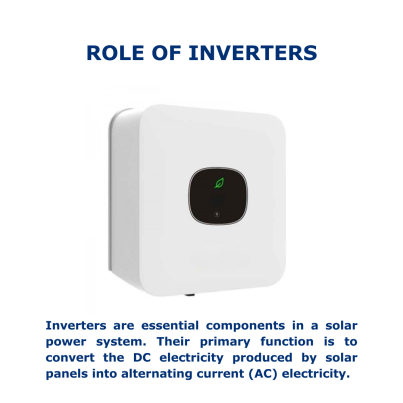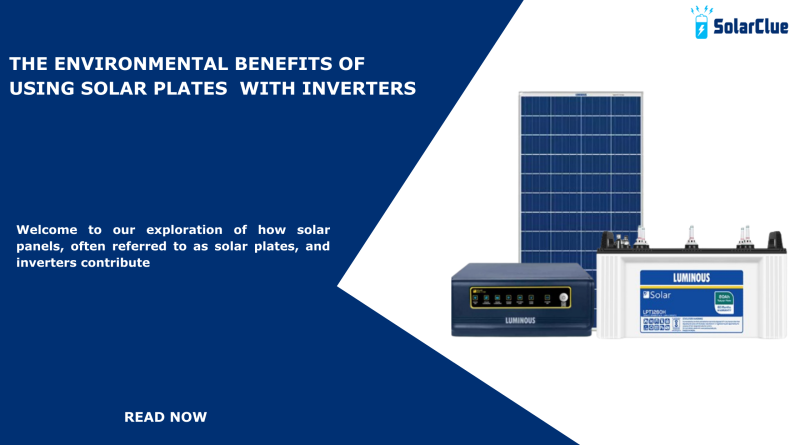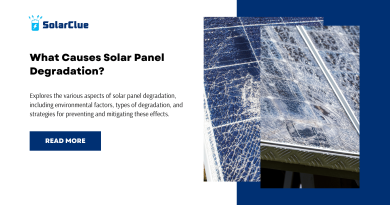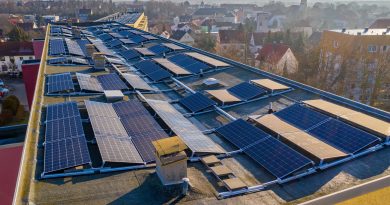The Environmental Benefits of Using Solar Plates with Inverters
Welcome to our exploration of how solar panels, often referred to as solar plate, and inverters contribute to a cleaner environment. In today’s world, where environmental sustainability is Important, adopting renewable energy sources like solar power can make a significant impact. Solar panels, when paired with inverters, play a pivotal role in taking the sun’s energy to generate electricity without harmful emissions. Let’s go into how these technologies work together to benefit our planet.
Table of Contents
Understanding Solar Plate/Panels:
Solar panels, also known as solar plates, are devices designed to capture sunlight and convert it into electricity. They are made up of photovoltaic cells that generate direct current (DC) electricity when exposed to sunlight. These panels are typically installed on rooftops or in open areas where they can receive maximum sunlight throughout the day.

Role of Inverters:
Inverters are essential components in a solar power system. Their primary function is to convert the DC electricity produced by solar panels into alternating current (AC) electricity. AC electricity is what most household appliances and electronics use. Inverters ensure that solar panels generate electricity compatible with the electrical grid, making it usable in homes and businesses.
Environmental Benefits of Solar Energy:
1.Reduction in Greenhouse Gas Emissions: One of the most significant environmental benefits of using solar panels with inverters is the reduction in greenhouse gas emissions. Unlike traditional fossil fuels such as coal and natural gas, which emit carbon dioxide and other pollutants when burned for electricity generation, solar power produces electricity with virtually no emissions during operation. This helps mitigate climate change and reduces our carbon footprint.
2.Conservation of Natural Resources: Solar energy is derived from sunlight, a renewable resource that is abundant and freely available. By harnessing solar power, we reduce our dependence on finite fossil fuels that contribute to resource depletion and environmental degradation. Solar panels allow us to generate electricity sustainably without depleting natural resources.
3.Improved Air Quality: Traditional energy sources like coal-fired power plants emit pollutants such as sulfur dioxide, nitrogen oxides, and particulate matter, which can harm air quality and human health. In contrast, solar power generation produces clean electricity without emitting harmful pollutants, thereby leading to improved air quality and a healthier environment for communities.
Financial Benefits of Solar Energy:
Apart from the environmental advantages, solar panels with inverters offer financial benefits as well:
Reduced Electricity Bills: By generating electricity from solar power, homeowners can significantly reduce their monthly electricity bills or even eliminate them entirely, depending on the size of the solar system and energy consumption.
Return on Investment (ROI): While there is an initial investment in purchasing and installing solar panels and inverters, they typically pay for themselves over time through energy savings. Many governments and utilities also offer incentives, rebates, or tax credits to encourage the adoption of solar energy, thereby further enhancing the financial benefits.
Conclusion:
The combination of solar panels (or solar plates) with inverters offers significant environmental and financial benefits. By harnessing the power of the sun to generate clean electricity, we can reduce greenhouse gas emissions, conserve natural resources, and improve air quality. Solar energy is not only environmentally friendly but also economically viable, offering long-term savings and energy independence for homeowners and businesses alike.
Investing in solar systems with inverters is a proactive step toward a sustainable energy future, mitigating climate change and securing a cleaner environment for future generations. Inverters ensure that solar panels generate electricity compatible with the electrical grid, making it usable in homes and businesses. Individuals and communities worldwide benefit from solar power’s reliable and renewable solutions, driven by environmental concerns, financial savings, or energy independence.
If you’re considering installing a solar system with inverters, explore options with reputable providers to contribute to a greener tomorrow for your home or business. Together, we can harness the power of solar energy to create a brighter and more sustainable future for all.
Visit SolarClue® to see the best Solar Inverters. SolarClue® actively sells solar energy products at discounts of up to 50% on its online marketplace.
Frequently Asked Questions
1.Can we make solar plate at home?
You can make your own small solar panel with some inexpensive components and basic soldering skills. Harnessing the power of the sun through solar panels to create electricity seems both complicated and magical.
2.How many solar panels do we need?
The average household needs between 15 and 20 solar panels to offset their energy needs. However, specific individual requirements vary based on energy usage, roof size, roof orientation, and location.
3. Which type of solar panel is best for home use?
Monocrystalline solar panels are the best option for residential solar panel systems.




